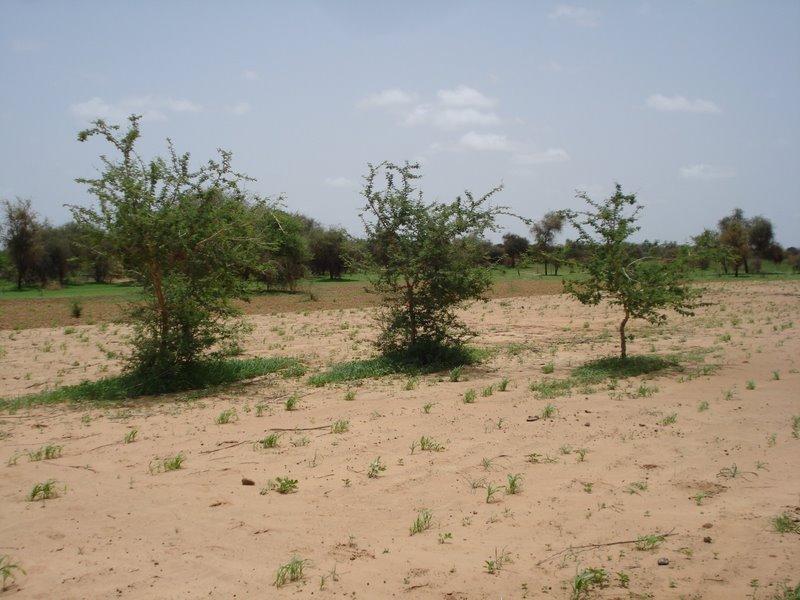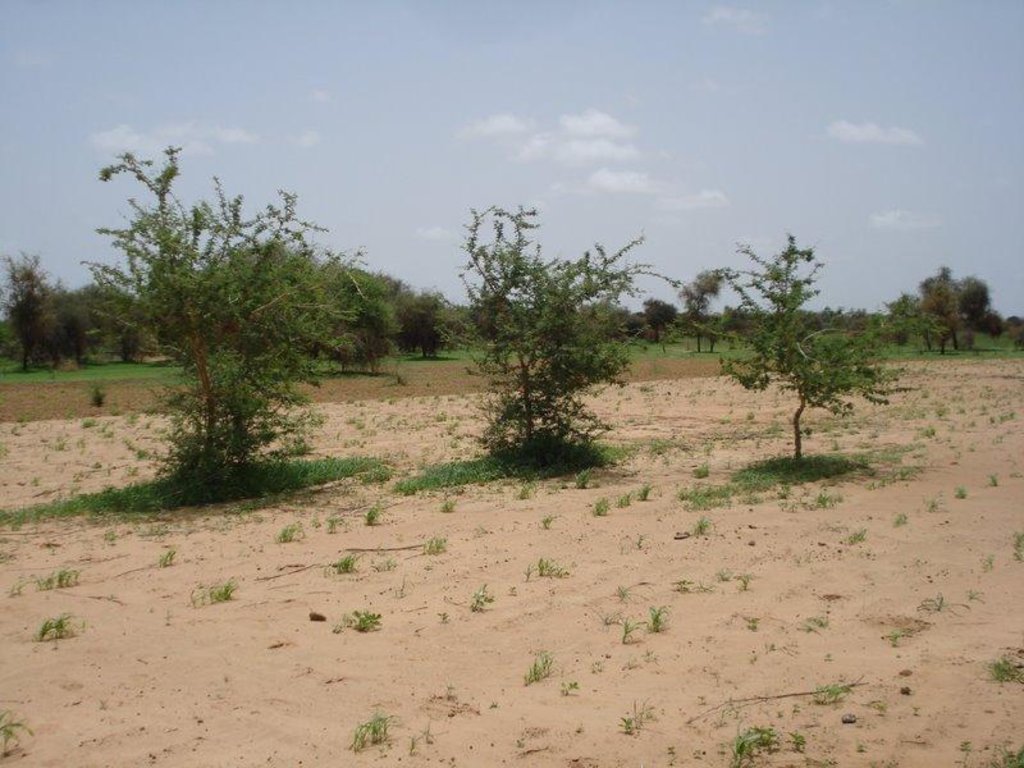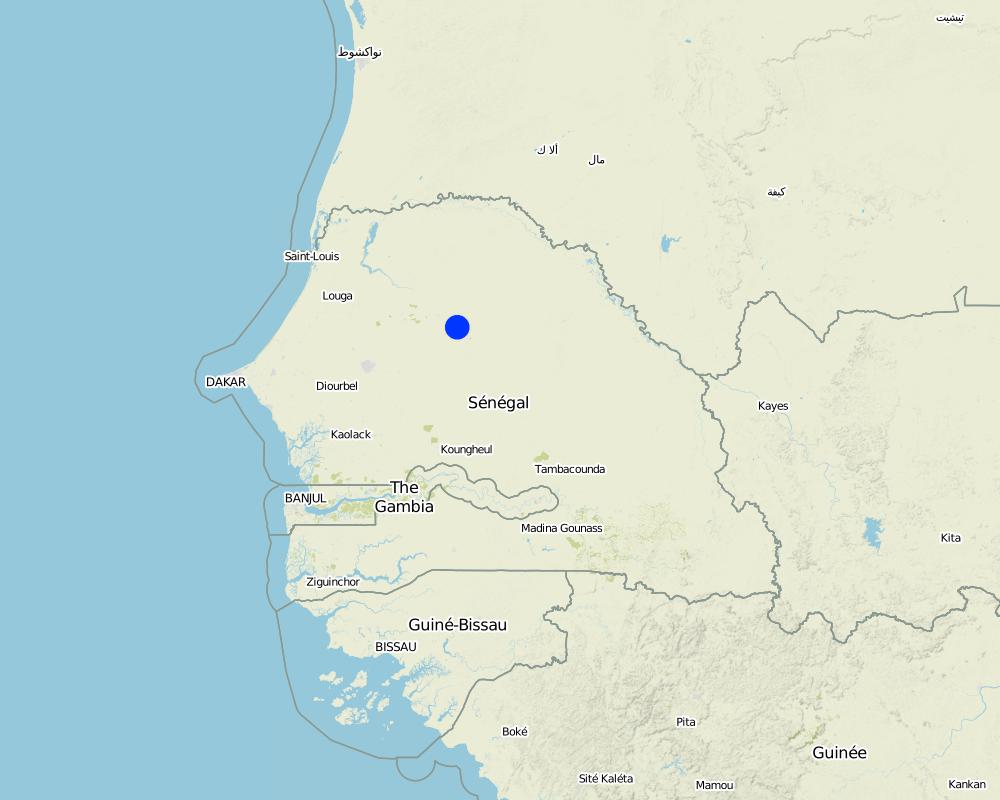Agroforestry with Acacia senegal [Senegal]
- Creation:
- Update:
- Compiler: Julie Zähringer
- Editor: –
- Reviewers: Fabian Ottiger, Alexandra Gavilano
technologies_1119 - Senegal
View sections
Expand all Collapse all1. General information
1.2 Contact details of resource persons and institutions involved in the assessment and documentation of the Technology
SLM specialist:
Name of the institution(s) which facilitated the documentation/ evaluation of the Technology (if relevant)
CDE Centre for Development and Environment (CDE Centre for Development and Environment) - SwitzerlandName of the institution(s) which facilitated the documentation/ evaluation of the Technology (if relevant)
CSE (CSE) - Senegal1.3 Conditions regarding the use of data documented through WOCAT
The compiler and key resource person(s) accept the conditions regarding the use of data documented through WOCAT:
Yes
2. Description of the SLM Technology
2.1 Short description of the Technology
Definition of the Technology:
An agroforestry system, dominated by Acacia senegal, developed through protection of all naturally regenerating trees with improvement of soil properties through presence of trees, application of manure and a fallow rotation.
2.2 Detailed description of the Technology
Description:
Acacia senegal is the dominating woody species in this agroforestry system. To improve soil properties and crop production, organic manure is applied and a fallow system practiced. One part of the field is being cultivated with either millet (Pennisetum typhoides), cowpea (Vigna unguiculata), groundnut (Arachis hypogaea) or maïz (Zea mais] whereas the other part is left fallow for two years before rotation.
Purpose of the Technology: Initially, the main objective of the land user applying the technology was to improve soil properties and crop production in his fields by maintaining any tree and protecting natural regeneration when preparing his land for cultivation. With the start of exploiting Acacia senegal for the exudates, gum arabic, the potential of revenue increase through gum exploitation became evident and the objective shifted from soil protection to gum exploitation.
Establishment / maintenance activities and inputs: Because of knowledge his father passed on to him, the land user applying this agroforestry practice believes that any tree in his fields is useful and should be protected.Through the technique of assisted natural regeneration, trees naturally growing in the field are protected to reach mature age instead of being cut to clear area for cultivation. The only inputs related to this technology are those for seeds for crop cultivation. During the 3-4 months of gum Arabic exploitation, the land user is obliged to survey his fields day and night, as intruders try to tap the Acacia senegal trees illegally. However, this task is fulfilled by the landuser himself and does not involve expenses for payed manpower.
Natural / human environment: This SLM technology site is located in the sylvopastoral region of the Ferlo in the north of Sénégal. The agro-climatic zone is classified as semi-arid with mean annual precipitation of 300-400 mm. The main land use type in the area is extensive pastoralism followed by rainfed agriculture. Pastoralism is primarily practiced by transhumant Fula (Peulh) herders and further by Mauritanian Moor herders with herds of dromedaries. Vegetation cover in the area has been largely degraded due to cutting for domestic uses and cattle feeding, bushfires and overgrazing. The soil is exposed to wind erosion which carries away nutrients in the topsoil and therefore declines soil fertility. During intense rains in the rainy season, surface runoff is accelerated and leads to the formation of gullies and ravines.
2.3 Photos of the Technology
2.5 Country/ region/ locations where the Technology has been applied and which are covered by this assessment
Country:
Senegal
Region/ State/ Province:
Louga
Further specification of location:
Barkédji
Comments:
Total area covered by the SLM Technology is 0.35 km2.
Map
×2.6 Date of implementation
If precise year is not known, indicate approximate date:
- 10-50 years ago
2.7 Introduction of the Technology
Specify how the Technology was introduced:
- through land users' innovation
Comments (type of project, etc.):
family tradition: the father taught the sons not to cut any trees in their fields, as they have beneficial properties
3. Classification of the SLM Technology
3.1 Main purpose(s) of the Technology
- improve production
- reduce, prevent, restore land degradation
- create beneficial economic impact
3.2 Current land use type(s) where the Technology is applied
Land use mixed within the same land unit:
Yes
Specify mixed land use (crops/ grazing/ trees):
- Agroforestry

Cropland
- Annual cropping
Annual cropping - Specify crops:
- cereals - millet
- legumes and pulses - peas
- oilseed crops - groundnuts
Number of growing seasons per year:
- 1
Specify:
Longest growing period in days: 120 Longest growing period from month to month: July to October

Forest/ woodlands
Type of tree:
- Acacia senegal
Comments:
Major cash crop: Acacia senegal
Major food crop: Millet, groundnut, cowpea
Major land use problems (compiler’s opinion): degradation of vegetation cover, wind erosion, increased surface runoff, formation of gullies and ravines, management of natural water sources (people doing laundry and personal hygiene in temporal ponds used as sources of drinking water)
Major land use problems (land users’ perception): wind erosion, water erosion, reduction of vegetation cover
3.4 Water supply
Water supply for the land on which the Technology is applied:
- rainfed
3.5 SLM group to which the Technology belongs
- agroforestry
- rotational systems (crop rotation, fallows, shifting cultivation)
3.6 SLM measures comprising the Technology

agronomic measures
- A1: Vegetation/ soil cover

vegetative measures
- V1: Tree and shrub cover
Comments:
Main measures: agronomic measures, vegetative measures
Type of agronomic measures: manure / compost / residues
3.7 Main types of land degradation addressed by the Technology

soil erosion by water
- Wt: loss of topsoil/ surface erosion

soil erosion by wind
- Et: loss of topsoil

chemical soil deterioration
- Cn: fertility decline and reduced organic matter content (not caused by erosion)

biological degradation
- Bc: reduction of vegetation cover
- Bq: quantity/ biomass decline
- Bs: quality and species composition/ diversity decline
Comments:
Main type of degradation addressed: Et: loss of topsoil, Cn: fertility decline and reduced organic matter content, Bc: reduction of vegetation cover, Bs: quality and species composition /diversity decline
Secondary types of degradation addressed: Wt: loss of topsoil / surface erosion, Bq: quantity / biomass decline
Main causes of degradation: soil management (absence of inorganic fertilizers, reduction of fallow period), deforestation / removal of natural vegetation (incl. forest fires) (domestic uses), over-exploitation of vegetation for domestic use, overgrazing (oversized herds of cattle and dromadaires), Heavy / extreme rainfall (intensity/amounts) (during rainy season), population pressure (need for pasture and cultivable land), poverty / wealth, education, access to knowledge and support services
3.8 Prevention, reduction, or restoration of land degradation
Specify the goal of the Technology with regard to land degradation:
- prevent land degradation
4. Technical specifications, implementation activities, inputs, and costs
4.1 Technical drawing of the Technology
Technical specifications (related to technical drawing):
Technical knowledge required for land users: low
Main technical functions: increase in organic matter, increase in nutrient availability (supply, recycling,…), increase of biomass (quantity)
Secondary technical functions: promotion of vegetation species and varieties (quality, eg palatable fodder)
Manure / compost / residues
Material/ species: organic manure (untreated)
4.3 Establishment activities
| Activity | Timing (season) | |
|---|---|---|
| 1. | Get all the seeds |
4.4 Costs and inputs needed for establishment
| Specify input | Unit | Quantity | Costs per Unit | Total costs per input | % of costs borne by land users | |
|---|---|---|---|---|---|---|
| Plant material | Seeds for millet | ha | 1.0 | 1.68 | 1.68 | |
| Plant material | Seeds for groundnut | ha | 1.0 | 5.25 | 5.25 | |
| Plant material | Seeds for cowpeas | ha | 1.0 | 7.85 | 7.85 | |
| Total costs for establishment of the Technology | 14.78 | |||||
| Total costs for establishment of the Technology in USD | 14.78 | |||||
4.5 Maintenance/ recurrent activities
| Activity | Timing/ frequency | |
|---|---|---|
| 1. | Sowing of crops | beginning of growing season once a year |
| 2. | Application of manure | several times during growing season |
4.6 Costs and inputs needed for maintenance/ recurrent activities (per year)
Comments:
The landuser has to spend 90-120 person days for surveillance of his Acacia senegal trees every year during the exploitation of gum arabic. No costs incur to the landuser because of this activity, as he or somebody from his family is undertaking the task.The protection of natural regeneration in the fields does not have any costs, as the young trees are not enclosured.
4.7 Most important factors affecting the costs
Describe the most determinate factors affecting the costs:
seeds for crop planting
5. Natural and human environment
5.1 Climate
Annual rainfall
- < 250 mm
- 251-500 mm
- 501-750 mm
- 751-1,000 mm
- 1,001-1,500 mm
- 1,501-2,000 mm
- 2,001-3,000 mm
- 3,001-4,000 mm
- > 4,000 mm
Specify average annual rainfall (if known), in mm:
300.00
Specifications/ comments on rainfall:
During one rainy season (july-september), dry period from october-mai
Agro-climatic zone
- semi-arid
Thermal climate class: tropics, in the sylvopastoral zone of the Ferlo
5.2 Topography
Slopes on average:
- flat (0-2%)
- gentle (3-5%)
- moderate (6-10%)
- rolling (11-15%)
- hilly (16-30%)
- steep (31-60%)
- very steep (>60%)
Landforms:
- plateau/plains
- ridges
- mountain slopes
- hill slopes
- footslopes
- valley floors
Altitudinal zone:
- 0-100 m a.s.l.
- 101-500 m a.s.l.
- 501-1,000 m a.s.l.
- 1,001-1,500 m a.s.l.
- 1,501-2,000 m a.s.l.
- 2,001-2,500 m a.s.l.
- 2,501-3,000 m a.s.l.
- 3,001-4,000 m a.s.l.
- > 4,000 m a.s.l.
5.3 Soils
Soil depth on average:
- very shallow (0-20 cm)
- shallow (21-50 cm)
- moderately deep (51-80 cm)
- deep (81-120 cm)
- very deep (> 120 cm)
Soil texture (topsoil):
- coarse/ light (sandy)
- fine/ heavy (clay)
Topsoil organic matter:
- low (<1%)
If available, attach full soil description or specify the available information, e.g. soil type, soil PH/ acidity, Cation Exchange Capacity, nitrogen, salinity etc.
Soil fertility: High (ranked 1) and medium (ranked 2)
Soil drainage/infiltration: Medium
Soil water storage capacity: Medium
5.4 Water availability and quality
Availability of surface water:
poor/ none
Water quality (untreated):
poor drinking water (treatment required)
Comments and further specifications on water quality and quantity:
Water quality (untreated): Poor drinking water (treatement required, ranked 1, groundwater from borehole during dry season) and for agricultural use only (irrigation, ranked 2, water from temporary ponds during the rainy season)
5.5 Biodiversity
Species diversity:
- medium
Comments and further specifications on biodiversity:
Compared to the sudano-guinean zones of the country, this zone is not very species rich
5.6 Characteristics of land users applying the Technology
Market orientation of production system:
- subsistence (self-supply)
- mixed (subsistence/ commercial)
Off-farm income:
- less than 10% of all income
Relative level of wealth:
- average
Individuals or groups:
- individual/ household
Level of mechanization:
- manual work
- animal traction
Gender:
- men
Indicate other relevant characteristics of the land users:
Land users applying the Technology are mainly common / average land users
Difference in the involvement of women and men: women do not have the right to ask for land to cultivate, it can only been attributed to them by their husbands
Population density: < 10 persons/km2
Annual population growth: 2% - 3%
22% of the land users are average wealthy.
Off-farm income specification: no off-farm income (if income generated through gum exploitation is seen as farm income)
Market orientation: Subsistence (ranked 1) and Mixed (ranked 2, only gum from Acacia senegal is sold)
5.7 Average area of land used by land users applying the Technology
- < 0.5 ha
- 0.5-1 ha
- 1-2 ha
- 2-5 ha
- 5-15 ha
- 15-50 ha
- 50-100 ha
- 100-500 ha
- 500-1,000 ha
- 1,000-10,000 ha
- > 10,000 ha
Is this considered small-, medium- or large-scale (referring to local context)?
- medium-scale
Comments:
The single landuser applying the technology exploits cropland of about 35 ha
5.8 Land ownership, land use rights, and water use rights
Land ownership:
- state
- individual, not titled
Land use rights:
- communal (organized)
Water use rights:
- communal (organized)
5.9 Access to services and infrastructure
health:
- poor
- moderate
- good
education:
- poor
- moderate
- good
technical assistance:
- poor
- moderate
- good
employment (e.g. off-farm):
- poor
- moderate
- good
markets:
- poor
- moderate
- good
energy:
- poor
- moderate
- good
roads and transport:
- poor
- moderate
- good
drinking water and sanitation:
- poor
- moderate
- good
financial services:
- poor
- moderate
- good
6. Impacts and concluding statements
6.1 On-site impacts the Technology has shown
Socio-economic impacts
Production
crop production
risk of production failure
Comments/ specify:
As the land user can count on income from gum exploitation he is less vulnerable to crop failure
product diversity
production area
Comments/ specify:
Applies especially for fallow part, cultivation might be entirely given up
Income and costs
farm income
Comments/ specify:
Income from gum arabic exploitation
diversity of income sources
Socio-cultural impacts
food security/ self-sufficiency
conflict mitigation
Ecological impacts
Soil
soil cover
Comments/ specify:
Applies for the part left fallow, in the cultivated part negligible
soil loss
Comments/ specify:
Applies for the part left fallow, in the cultivated part negligible
nutrient cycling/ recharge
Comments/ specify:
Biological N-fixation (A.senegal), but amount questionable
soil organic matter/ below ground C
Comments/ specify:
Through plant litterfall, application of manure
Biodiversity: vegetation, animals
biomass/ above ground C
Comments/ specify:
Mainly applies for the part left fallow, in the cultivated part only little
plant diversity
Comments/ specify:
Applies for the cultivated part only
pest/ disease control
Comments/ specify:
Birds building nests in trees on fields
Climate and disaster risk reduction
wind velocity
Comments/ specify:
Applies for the part left fallow, in the cultivated part negligible
6.2 Off-site impacts the Technology has shown
wind transported sediments
6.3 Exposure and sensitivity of the Technology to gradual climate change and climate-related extremes/ disasters (as perceived by land users)
Gradual climate change
Gradual climate change
| Season | increase or decrease | How does the Technology cope with it? | |
|---|---|---|---|
| annual temperature | increase | well |
Climate-related extremes (disasters)
Meteorological disasters
| How does the Technology cope with it? | |
|---|---|
| local rainstorm | not known |
| local windstorm | not known |
Climatological disasters
| How does the Technology cope with it? | |
|---|---|
| drought | not known |
Hydrological disasters
| How does the Technology cope with it? | |
|---|---|
| general (river) flood | not well |
Other climate-related consequences
Other climate-related consequences
| How does the Technology cope with it? | |
|---|---|
| reduced growing period | not well |
6.4 Cost-benefit analysis
How do the benefits compare with the establishment costs (from land users’ perspective)?
Short-term returns:
positive
Long-term returns:
very positive
How do the benefits compare with the maintenance/ recurrent costs (from land users' perspective)?
Short-term returns:
positive
Long-term returns:
very positive
Comments:
the landuser is expecting a rise in income through increased gum production
6.5 Adoption of the Technology
- single cases/ experimental
If available, quantify (no. of households and/ or area covered):
1
Of all those who have adopted the Technology, how many did so spontaneously, i.e. without receiving any material incentives/ payments?
- 91-100%
Comments:
100% of land user families have adopted the Technology without any external material support
1 land user families have adopted the Technology without any external material support
There is a little trend towards spontaneous adoption of the Technology
6.7 Strengths/ advantages/ opportunities of the Technology
| Strengths/ advantages/ opportunities in the land user’s view |
|---|
|
increase of crop production How can they be sustained / enhanced? maintain or increase number of trees in fields |
|
increase of income How can they be sustained / enhanced? assist natural regeneration of Acacia senegal |
|
provision of shade for cattle and increased availability of manure as consequence How can they be sustained / enhanced? maintain or increase number of trees in fields |
| Strengths/ advantages/ opportunities in the compiler’s or other key resource person’s view |
|---|
|
increase of soil fertility increase of soil organic matter How can they be sustained / enhanced? increase the number of trees with positive impact on soil fertility improve manure application and increase number of trees in cultivated part |
|
reduction of wind erosion How can they be sustained / enhanced? increase tree abundance |
| maintenance of woody species diversity |
|
improvement of soil cover How can they be sustained / enhanced? increase tree abundance |
| little to no costs of establishment |
6.8 Weaknesses/ disadvantages/ risks of the Technology and ways of overcoming them
| Weaknesses/ disadvantages/ risks in the land user’s view | How can they be overcome? |
|---|---|
| surveillance of Acacia senegal trees during exploitation season required | establish a fence |
| crop damaging birds find a habitat to build nests in trees | put scarecrows |
| Weaknesses/ disadvantages/ risks in the compiler’s or other key resource person’s view | How can they be overcome? |
|---|---|
| tendency towards a monoculture of Acacia senegal (in the part of the field left fallow) | encourage natural regeneration of other local species as well |
7. References and links
7.1 Methods/ sources of information
Links and modules
Expand all Collapse allLinks
No links
Modules
No modules




